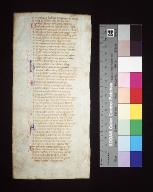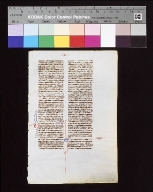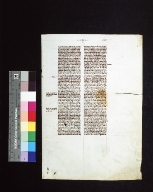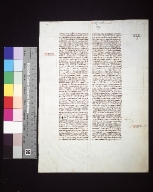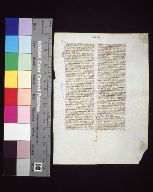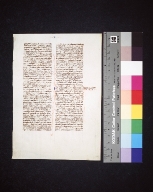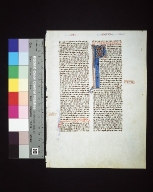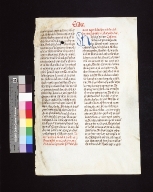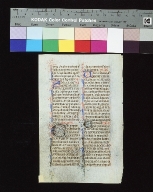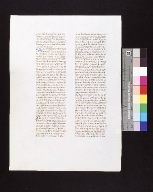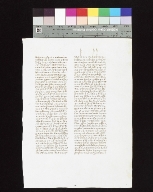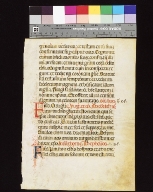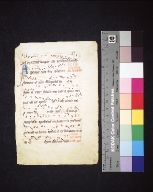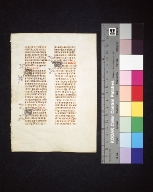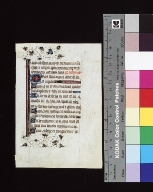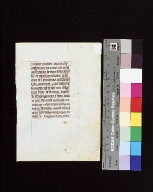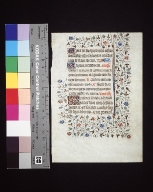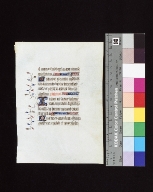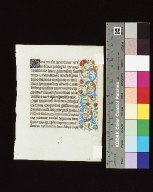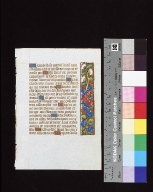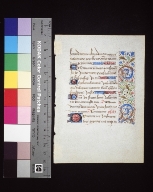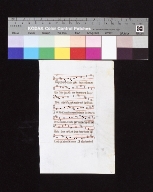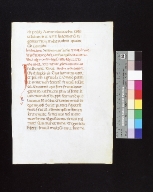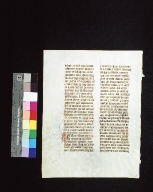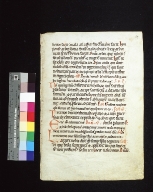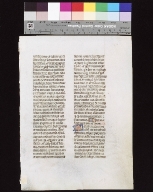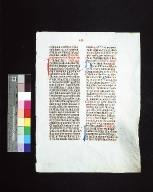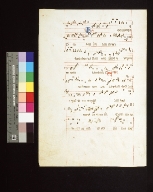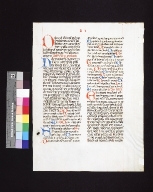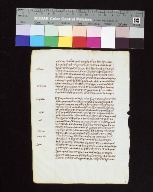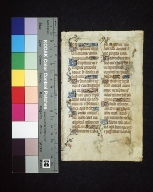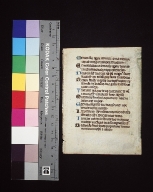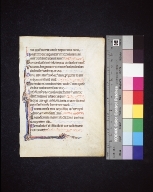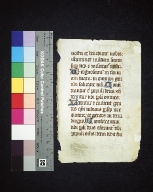|
Title
Ab urbe condita: fragment
Creator
Livy
Summary
[Ms. This manuscript leaf is part of a collection of medieval manuscript leaves selected to illustrate the art of the manuscript during the period of its greatest development and influence. They have been taken from books written in various European scriptoria by Benedictine, Franciscan, Carthusian, Dominican, and other orders of monks. Many are enriched with handsome borders, initial letters, and line-endings rendered in color. Twenty-five are illuminated with burnished gold or silver. The texts include the Bible, various church service books, the writings of the Church fathers, and some of the Classics., In Humanistic script., The known part of Livy's great life work, the History of Rome, was completed about the year 9 A.D. The finished work consisted of one hundred and forty-two books, of which only thirty-five are extant. These books are regarded as one of the most precious remains of Latin literature. One of the outstanding characteristics of the scholars and scribes of the Italian Renaissance was their great interest in Latin literature. Through their influence, many copies of the classics were made from the few 9th and 10th century manuscripts available. These earlier manuscripts had been written in a carolingian or pre-gothic script to which the 15th century humanistic calligraphers assigned the name antiqua littera. The letters were not really of antiquity, since minuscule letters were not known before the time of Charlemagne. In the 15th century, this carolingian script became the inspiration not only for manuscripts like this leaf, but also for the fine roman types designed by the printers in Italy. This vellum leaf was created in Italy.]
Title
Antiphonarium: fragment
Creator
Catholic Church
Summary
[Ms. This manuscript leaf is part of a collection of medieval manuscript leaves selected to illustrate the art of the manuscript during the period of its greatest development and influence. They have been taken from books written in various European scriptoria by Benedictine, Franciscan, Carthusian, Dominican, and other orders of monks. Many are enriched with handsome borders, initial letters, and line-endings rendered in color. Twenty-five are illuminated with burnished gold or silver. The texts include the Bible, various church service books, the writings of the Church fathers, and some of the Classics., In rotunda gothic script; Gregorian notation., The chanting of hymns during ecclesiastical rites goes back to the beginning of Christian services. Antiphonal or responsive singing is said to have been introduced in the second century by St. Ignatius of Antioch. According to legend, he had a vision of a heavenly choir singing in honor of the Blessed Trinity in the responsive manner. Many of the more than four hundred antiphons which have survived the centuries are elaborate in their musical structure. They were sung in the medieval church by the first cantor and his assistants. Candle grease stains reveal that this small-sized antiphonal was doubtless carried in processions in dimly lighted cathedrals. In this example the notation is written on the four-line red staff which was in general use by the end of the 12th century. The script is the usual form of Italian rotunda with bold Lombardic initial letters. This leaf was created in Italy.]
Title
Aurora: fragment
Creator
Peter Riga, ca. 1140-1209
Summary
[Ms. This manuscript leaf is part of a collection of medieval manuscript leaves selected to illustrate the art of the manuscript during the period of its greatest development and influence. They have been taken from books written in various European scriptoria by Benedictine, Franciscan, Carthusian, Dominican, and other orders of monks. Many are enriched with handsome borders, initial letters, and line-endings rendered in color. Twenty-five are illuminated with burnished gold or silver. The texts include the Bible, various church service books, the writings of the Church fathers, and some of the Classics., Early gothic script., This famous paraphrase of the Bible in Latin verse was one of the most popular Latin books of poetry of the late 12th and 13th century. Petrus de Riga, who died in 1209, began it. Aegidius of Paris finished it. This version did not appear in printed form until a very late ate, despite its popularity. The format of this page, twice as long as it is wide, demonstrates the English custom of folding the skins lengthwise. The practice of setting off by a space the initial letter of each line also helps to give the page an unusual appearance. It is written in a very small script, six lines to an inch, in a hand characteristic of Northern France and England at this period. This vellum leaf was created in England.]
Title
Biblia sacra Latina, versio vulgata : fragment
Summary
[Ms. This manuscript leaf is part of a collection of medieval manuscript leaves selected to illustrate the art of the manuscript during the period of its greatest development and influence. They have been taken from books written in various European scriptoria by Benedictine, Franciscan, Carthusian, Dominican, and other orders of monks. Many are enriched with handsome borders, initial letters, and line-endings rendered in color. Twenty-five are illuminated with burnished gold or silver. The texts include the Bible, various church service books, the writings of the Church fathers, and some of the Classics., In rotunda gothic script., In 1217, St. Dominic, the founder of the order which bears his name, withdrew from France and settled in Italy. Here, in the next four and last years of his life, he founded sixty more chapters of the Dominican order. Many of the younger members of the order studied at the University of Bologna and, while there, produced a great number of these small portable Bibles, just as did their brothers at the University of Paris in France and the University of Oxford in England. There was a difference in the art of the scriptoria in the various countries. In England and France}the ideal of craftsmanship was very high, while at this time, in Italy, a rather casual attitude prevailed. In the 13th century, Italy was distraught by the long struggle between the papal and anti-imperialistic Guelphs and the autocratic and imperialistic Ghibellines. Little encouragement was given by either party to the arts. This leaf reveals, however, the skill and keen eyesight which were necessary for the writing of ten of these lines to the inch. This vellum leaf was created in Italy.]
Title
Biblia sacra Latina, versio vulgata: fragment
Summary
[Ms. This manuscript leaf is part of a collection of medieval manuscript leaves selected to illustrate the art of the manuscript during the period of its greatest development and influence. They have been taken from books written in various European scriptoria by Benedictine, Franciscan, Carthusian, Dominican, and other orders of monks. Many are enriched with handsome borders, initial letters, and line-endings rendered in color. Twenty-five are illuminated with burnished gold or silver. The texts include the Bible, various church service books, the writings of the Church fathers, and some of the Classics., This translation of the Bible was made by Jerome at the request of Pope Damasus. It was begun in the year 382 A.D. and finished 16 years later. For his great scholarship more than for his eminent sanctity, Jerome was later made a saint. This version of the Bible was his most important work. The angular book hand, executed with amazing skill and precision, reflects the spirit of contemporary architecture of the early 13th century. Closely spaced perpendicular strokes and angular terminals have supplanted the open and round character of the preceding century. It is a beautiful book hand but exceedingly difficult to read. The quills used in writing were obtained from the wings of crows, wild geese, and eagles. To keep them sharp and their strokes of uniform width required skill and great sensitivity in hand pressure. It would be difficult to imitate or approximate the fine details even with the special steel lettering pens of today. This vellum leaf was created in France., In early angular gothic script.]
Title
Biblia sacra Latina, versio vulgata: fragment
Summary
[Ms. This manuscript leaf is part of a collection of medieval manuscript leaves selected to illustrate the art of the manuscript during the period of its greatest development and influence. They have been taken from books written in various European scriptoria by Benedictine, Franciscan, Carthusian, Dominican, and other orders of monks. Many are enriched with handsome borders, initial letters, and line-endings rendered in color. Twenty-five are illuminated with burnished gold or silver. The texts include the Bible, various church service books, the writings of the Church fathers, and some of the Classics., In early angular gothic script, The only Bible known to Western Europe for the thousand years from 400 to 1400 was this version by St. Jerome. In the early part of the 13th century it is almost impossible to distinguish the book hands of France from those of England. The decorative initials, color of ink, and texture of vellum are the clues which aid in assigning provenance, as in this instance. Not many fragments of this age and size are known to have survived the destruction and dispersal of English monastic libraries which was ordered by Henry VIII in the year 1539. This small size lettering, seven lines to the inch, is formed with the skill and precision that made the 13th century noted for the finest calligraphy of all time. To write seven lines to an inch, maintain evenness throughout, and have each letter clear and precise is a great achievement for any scribe, yet in the 13th century this was not an exceptional accomplishment. This vellum leaf was created in Cambridge, England.]
Title
Biblia sacra Latina, versio vulgata: fragment
Summary
[Ms. This manuscript leaf is part of a collection of medieval manuscript leaves selected to illustrate the art of the manuscript during the period of its greatest development and influence. They have been taken from books written in various European scriptoria by Benedictine, Franciscan, Carthusian, Dominican, and other orders of monks. Many are enriched with handsome borders, initial letters, and line-endings rendered in color. Twenty-five are illuminated with burnished gold or silver. The texts include the Bible, various church service books, the writings of the Church fathers, and some of the Classics., In minuscule angular gothic script, These miniature or portable manuscript copies of the Jerome version of the Bible were nearly all written by the young wandering friars of the newly founded order of Dominicans. With almost superhuman skill and patience, and without the aid of eyeglasses, an amazing number of these small Bibles were produced by writing with quills on uterine vellum or rabbit skins. Many such Bibles were produced for students at the early medieval universities and were made in such large quantities that today they are easy to find. The precision and beauty of the text letters and initials executed in so small a scale, twelve lines to an inch, with letters less than one-sixteenth of an inch high, are among the wonders in book history. This vellum leaf was created in Paris, France.]
Title
Biblia sacra Latina, versio vulgata: fragment
Summary
[Ms. This manuscript leaf is part of a collection of medieval manuscript leaves selected to illustrate the art of the manuscript during the period of its greatest development and influence. They have been taken from books written in various European scriptoria by Benedictine, Franciscan, Carthusian, Dominican, and other orders of monks. Many are enriched with handsome borders, initial letters, and line-endings rendered in color. Twenty-five are illuminated with burnished gold or silver. The texts include the Bible, various church service books, the writings of the Church fathers, and some of the Classics., In angular gothic script, It is usually difficult to distinguish the miniature or portable Bibles made by the young Dominican friars in England from those written in France. At times the colophon tells us that a book was executed in the Sorbonne, the newly founded school of theology in Paris, or in the University Center at Oxford. The Dominican order was founded in 1216 A.D. and soon spread all over Europe. About 1219 A.D., King Alexander of Scotland met St. Dominic in Paris and persuaded him to send some members of his brotherhood to Scotland. From here they spread to England. The original master text was carelessly transcribed again and again. It may even have been incorrectly copied from the Alcuinian text written for Charlemagne. Therefore, "correctories" had to be made. In the latter part of the 13th century, Roger Bacon condemned unsparingly manuscripts which, although they were skillfully and beautifully written, transmitted inaccuracies of text. This vellum leaf was created in Oxford, England.]
Title
Biblia sacra Latina, versio vulgata: fragment
Summary
[Ms. This manuscript leaf is part of a collection of medieval manuscript leaves selected to illustrate the art of the manuscript during the period of its greatest development and influence. They have been taken from books written in various European scriptoria by Benedictine, Franciscan, Carthusian, Dominican, and other orders of monks. Many are enriched with handsome borders, initial letters, and line-endings rendered in color. Twenty-five are illuminated with burnished gold or silver. The texts include the Bible, various church service books, the writings of the Church fathers, and some of the Classics., In angular gothic script, This copy of the Latin version by St. Jerome was made during the period when France stood at the height of her medieval glory. A decade or two before, Louis IX (Saint Louis), the strongest monarch of his age, had made France the mightiest power in Europe. This favorable political situation rendered possible the "golden age" of the manuscript, and Paris became the center in which the finest manuscripts were written and sold. In the quarter century from 1275 to 1300, marked advances were effected in the art. The bar borders came to be executed in rich opaque gouache pigments, with ultramarine made of powdered lapis lazuli predominating. The foliage scroll work inside the initial frame created a style that persisted with little or no change for nearly two hundred years. The script was well executed and was without rigidity or tension. All these elements, together with the sparkle which was created by the casual distribution of the burnished gold accents, give to this leaf a striking atmosphere of joyous freedom. This vellum leaf was created in France.]
Title
Biblia sacra Latina, versio vulgata: fragment
Summary
[Ms. This manuscript leaf is part of a collection of medieval manuscript leaves selected to illustrate the art of the manuscript during the period of its greatest development and influence. They have been taken from books written in various European scriptoria by Benedictine, Franciscan, Carthusian, Dominican, and other orders of monks. Many are enriched with handsome borders, initial letters, and line-endings rendered in color. Twenty-five are illuminated with burnished gold or silver. The texts include the Bible, various church service books, the writings of the Church fathers, and some of the Classics., In transitional rotunda script, At this period, the St. Jerome Bible was not transcribed as often as one would expect in the country of its origin and the very land which held the seat of the Roman Church. During the greater part of the 13th century, while the popes were greatly concerned with gaining political power, art was at a low ebb in Italy, and religious manuscripts were comparatively few and far inferior to the work of monastic scribes in Germany, France, and England. But with the great wealth accumulating in Italy during the 14th century through commerce and the Crusades, this country soon surpassed in richness as well as in numbers the manuscript outpout of all other nationalities. The rich black lettering of this manuscript is in the transitional rotunda script and is executed with skill and beauty. It is supplemented by initial letters in rich ultramarine blue and deep cinnabar (vermilion), which colors are reflected in the ornament of the romanesque capitals. All of these factors combine to indicate that the manuscript was executed in central Italy, possibly at Florence.]
Title
Biblia sacra Latina, versio vulgata: fragment
Summary
[Ms. This manuscript leaf is part of a collection of medieval manuscript leaves selected to illustrate the art of the manuscript during the period of its greatest development and influence. They have been taken from books written in various European scriptoria by Benedictine, Franciscan, Carthusian, Dominican, and other orders of monks. Many are enriched with handsome borders, initial letters, and line-endings rendered in color. Twenty-five are illuminated with burnished gold or silver. The texts include the Bible, various church service books, the writings of the Church fathers, and some of the Classics., In semi-gothic script, The Vulgate Bible, a translation credited to St. Jerome, was adopted by the Catholic Church as the authorized version. This leaf was written in Germany nearly sixty years after the invention of printing by movable type. Its semi-gothic book hand is very similar to the type-faces used by the early printers. The numerous contractions and marks of abbreviation have been inserted boldly, but the little strokes which were added to help identify the letters i and u are barely visible. The new art of printing concerned itself at once with the printing of Bibles of folio size, in Latin as well as the vernacular. In Germany, prior to the discovery of America, twelve printed editions of the Bible appeared in the German language and many others in Latin. An oversupply developed, and more than one printer of Bibles was forced into bankruptcy. This vellum leaf was created in Germany.]
Title
Book of hours, use of Rome
Summary
[TEXT: leaves 1-12 verso, Calendar in French -- leaves 13-17 verso, Hours of the Cross, with rubrics in French -- leaf 18 recto, blank; leaf 18 verso, originally blank with a Marian prayer added in the fifteenth century, beginning "[A]ve sanctissima Maria, mater Dei, regina celi, porta paradisi..." -- leaves 19-85 verso, Hours of the Virgin, use of Rome in the Netherlands, with rubrics in French -- leaf 86 recto and verso ruled, otherwise blank., Prayers are in Latin; calendar and rubrics are in French Gothic textualis script; Layout is 14 lines ruled in red ink., DECORATION: Capitals touched in yellow, 1- to 2-line initials alternating in red and blue throughout, many of the 2-line initials decorated with areas of parchment left in reserve. Nine 3- to 4-line puzzle initials with penwork flourishes alternating in red and blue. Black stains from pilgrims' badges on leaves 18 verso-19 and 37 verso-38, PROVENANCE: 1. The dialect of French used is Picard, spoken from the northernmost part of France to the southern Netherlands (modern Belgium). The liturgical use of the Hours of the Virgin, specifically the None capitulum "Sicut cinnamomum," and the penwork decoration, point more specifically to the southern Netherlands in the fifteenth century. The calendar lacks the feast of the Presentation of the Virgin (introduced in the Roman Missal in 1472), added to the calendar in a later hand. 2. On the first flyleaf and in the calendar are dated obits of the Despaigne and the D'Assonleville families. At the top of the flyleaf is the obit of Martine Despaigne: "Le vi decembre 1555 soier Martine despaigne a Rendu a dieu son esprit..." Below it, "Damp Jacques despaigne a Rendu a dieu son esprit, ... le dyxeysme Jour de Juin 1559 Dieu luy soit misericorde." In the calendar obits of Jeanne Despaigne dated 1598 (leaf 1 verso), Julye Despaigne dated 1580 (leaf 2), Jacques Despaigne 1559, date cropped (leaf 6), Marie Despaigne dated 1578 (leaf 9 verso), Marie D'Assonleville dated 1586 and Martine Despaigne dated 1555 (leaf 12). The D'Assonleville/D'Assonville family can be traced to Arras in Picardy in the 16th century. 3. In the margin of leaf 49 verso, an 18th or 19th century inscription in black ink "Rollet est im fripon" (Rollet is a rascal). An initial "D" by the same hand in the margin of leaf 37 verso., Bound in the 18th or 19th century using leather from an earlier binding in dark brown morocco over tan-colored leather over wooden boards, the morocco blind-tooled with a frame of triple fillets. The earlier morocco leather is very worn and covers the boards only partly, and the leather underneath is also worn. Traces of a single clasp on the front cover]
Title
Breviarium: fragment
Creator
Catholic Church
Summary
[Ms. This manuscript leaf is part of a collection of medieval manuscript leaves selected to illustrate the art of the manuscript during the period of its greatest development and influence. They have been taken from books written in various European scriptoria by Benedictine, Franciscan, Carthusian, Dominican, and other orders of monks. Many are enriched with handsome borders, initial letters, and line-endings rendered in color. Twenty-five are illuminated with burnished gold or silver. The texts include the Bible, various church service books, the writings of the Church fathers, and some of the Classics., In script, Breviaries were seldom owned by laymen. They were service books and contained the Psalter with the versicles, responses, collects and lections for Sundays, weekdays, and saints' days. Other texts could be included. A Breviary, therefore, was lengthy and usually bulky in format. Miniature copies like the one represented by this leaf are rare. The angular gothic script required a skilled calligrapher. It would be difficult for a modern engrosser to match, even with steel pens, the exactness and sharpness of these letters formed with a quill by a 13th century scribe. Green was a decorative color added to the palette in the late 13th century in many scriptoria. The medieval formulae for making it from earth, flowers, berries, and metals are often elaborate and strange. This manuscript was written on fine uterine vellum, i.e., the skin of an unborn calf. It evidently had hard use, or may have been buried with its owner. This vellum leaf was created in France.]
Title
Breviarium: fragment
Creator
Catholic Church
Summary
[Ms. This manuscript leaf is part of a collection of medieval manuscript leaves selected to illustrate the art of the manuscript during the period of its greatest development and influence. They have been taken from books written in various European scriptoria by Benedictine, Franciscan, Carthusian, Dominican, and other orders of monks. Many are enriched with handsome borders, initial letters, and line-endings rendered in color. Twenty-five are illuminated with burnished gold or silver. The texts include the Bible, various church service books, the writings of the Church fathers, and some of the Classics., In angular gothic script, The Breviary is one of the six official books used by the Roman Catholic Church in its liturgy. It is a book of prayer for the clergy, giving the directions for all of the various services of the Divine Hours throughout the year. The other five official books are the Pontifical, the Missal, the Ritual, the Martyrology, and the Ceremonial of the Bishops. The angular script in this leaf is executed with great skill and precision. The small and vigorous black initials and the hair line details found in many of the ascenders and terminal letters indicate the work of a superior calligrapher, skilled not only in writing but also in sharpening his quill. The initials and the dorsal decorations also represent the same high standard of craftsmanship. Strangely, the rubrications do not show as great a calligraphic skill. Usually it was the task of a superior scribe to insert the rubrics or directions for conducting the service. This vellum leaf was created in France.]
Title
Breviarium: fragment
Creator
Catholic Church
Summary
[Ms. This manuscript leaf is part of a collection of medieval manuscript leaves selected to illustrate the art of the manuscript during the period of its greatest development and influence. They have been taken from books written in various European scriptoria by Benedictine, Franciscan, Carthusian, Dominican, and other orders of monks. Many are enriched with handsome borders, initial letters, and line-endings rendered in color. Twenty-five are illuminated with burnished gold or silver. The texts include the Bible, various church service books, the writings of the Church fathers, and some of the Classics., In angular gothic script, In the middle of the 14th century many of the manuscripts show influences from other countries. Illuminators, scribes, and other craftsmen traveled from city to city and even from country to country. While the script of this leaf is almost certainly French, the initial letters and filigree decoration might easily be of Italian workmanship, and the greenish tone of the ink suggests English manufacture. The dorsal motif in the bar ornament is again decidedly French, and the lemon tone of the gold is a third indication of French origin. In England, the burnished gold elements are generally of an orange tint, due to the presence of an alloy; in Italy, they are a rosy color because the underlying gesso or plaster base was mixed with a red pigment. This vellum leaf was created in France.]
Title
Contra Jovinianum: fragment
Creator
Jerome, Saint, d. 419 or 20
Summary
[Ms. This manuscript leaf is part of a collection of medieval manuscript leaves selected to illustrate the art of the manuscript during the period of its greatest development and influence. They have been taken from books written in various European scriptoria by Benedictine, Franciscan, Carthusian, Dominican, and other orders of monks. Many are enriched with handsome borders, initial letters, and line-endings rendered in color. Twenty-five are illuminated with burnished gold or silver. The texts include the Bible, various church service books, the writings of the Church fathers, and some of the Classics., In letter de somme, Jerome, the father of the Latin Church and translator of the Bible, shows in his writing his active participation in the controversies of his day (c. 332 to 420 A.D.). With the frequent use of vehement invective, he is often as biting as Juvenal or Martial. This fine book hand, lettre de somme, obtained its name from the fact that Fust and Schoeffer used a type based on it for the printing of their Summa Theologica of St. Thomas Aquinas in 1467. It was the favorite manuscript book hand in the second half of the 15th century for the transcribing of French chronicles and romances. Simplicity and dignity are maintained by omitting all enrichment around the burnished gold letters. The first printed books followed the practice seen here of marking off by hand and with a stroke of red the capitals at the beginning of each sentence. Fifteenth century ink frequently had a tendency to fade to a gray tone as in this example. This vellum leaf was created in France.]
Title
Dialogi: fragment
Creator
Gregory I, Pope, approximately 540-604
Summary
[Ms. This manuscript leaf is part of a collection of medieval manuscript leaves selected to illustrate the art of the manuscript during the period of its greatest development and influence. They have been taken from books written in various European scriptoria by Benedictine, Franciscan, Carthusian, Dominican, and other orders of monks. Many are enriched with handsome borders, initial letters, and line-endings rendered in color. Twenty-five are illuminated with burnished gold or silver. The text includes the Bible, various church service books, the writings of the Church fathers, and some of the Classic., In letter bátarde script, This composite text includes the Dialogues of Pope Gregory I (St. Gregory the Great, 540-604 A.D.), which are largely autobiographical, and his writing on the lives and miracles of the early Italian Church Fathers. The book hand used is known as letter bátarde, a semi-cursive hand closely related to the everyday writing used by the people. Many French and Flemish printing types were based on similar bátarde hands. The writing was done with comparative speed; the even tone and the exact alignment of the right hand margin, as well as the beauty of individual letters, are admirable. The long ascenders in the upper line were borrowed from the legal documents of the day. Many printers followed the practice shown here of emphasizing the tone of the first word or two in the beginning of a paragraph. It was usually done without varying the style of the letters, while here we see angular gothic used in the first third of the line, followed by the bátarde script. This vellum leaf was created in late fifteenth-century France.]
Title
Epistolarium: fragment
Creator
Catholic Church
Summary
[Ms. This manuscript leaf is part of a collection of medieval manuscript leaves selected to illustrate the art of the manuscript during the period of its greatest development and influence. They have been taken from books written in various European scriptoria by Benedictine, Franciscan, Carthusian, Dominican, and other orders of monks. Many are enriched with handsome borders, initial letters, and line-endings rendered in color, and twenty-five are illuminated with burnished gold or silver. The texts include the Bible, various church service books, the writings of the Church fathers, and some of the Classics., Written in Rotunda or Round Gothic Script, square rehtorical neumes, Epistolaries are among the rarest of liturgical manuscripts. Their text consists of the Epistles and Gospels with lessons from the Old Testament for particular occasions. Sometimes, as in this leaf, they had interlinear neumes in red to assist the deacon or sub-deacon in chanting parts of this section of the church service while he was standing on the second step in front of the altar. The text is written in well-executed rotunda gothic script with bold Lombardic initials. Some of the filigree decoration which surrounds the initial letters has faded because it was executed in some of the fugitive colors which were then prepared from the juices of such flowers and plants as tumeric, saffron, lilies, and prugnameroli (buckthorn berries). This vellum leaf was created in mid-fifteenth century Italy.]
Title
Graduale: fragment
Creator
Catholic Church
Summary
[Ms. This manuscript leaf is part of a collection of medieval manuscript leaves selected to illustrate the art of the manuscript during the period of its greatest development and influence. They have been taken from books written in various European scriptoria by Benedictine, Franciscan, Carthusian, Dominican, and other orders of monks. Many are enriched with handsome borders, initial letters, and line-endings rendered in color. Twenty-five are illuminated with burnished gold or silver. The texts include the Bible, various church service books, the writings of the Church fathers, and some of the Classics., In early angular gothic script; square Gregorian notation, Graduals are the books containing the chants for the celebration of the mass. English manuscripts of this early date and small size are rare. This volume, with the uncertain strokes in the script, seems to indicate that the transcriber was unaccustomed to writing in this small scale. There are four and five line staves, and the "F" and "C" lines are indicated. Most of the various foms of written notes can be found on each leaf of this book. Thos occurring more frequently are punctum (L. punctum, prick), a single note; virga (L. virga, rod), a square note with a thin line attached; podatus (L. pes, foot), two square notes, one above the other; climacus (L. climax, ladder), a virga note with two or more diamond shaped notes. There are other forms for particular nuances of expression. There are more than 2,300 chants which have come down to us from the Middle Ages. The majority of these, however, can be reduced to a relatively few melodic types--probably not exceeding fifty in all. This vellum leaf was created in England.]
Title
Graduale: fragment
Creator
Catholic Church
Summary
[Ms. This manuscript leaf is part of a collection of medieval manuscript leaves selected to illustrate the art of the manuscript during the period of its greatest development and influence. They have been taken from books written in various European scriptoria by Benedictine, Franciscan, Carthusian, Dominican, and other orders of monks. Many are enriched with handsome borders, initial letters, and line-endings rendered in color. Twenty-five are illuminated with burnished gold or silver. The texts include the Bible, various church service books, the writings of the Church fathers, and some of the Classics., In rotunda gothic script, A Gradual contains the appropriate antiphons of a mass sung by the choir of the Latin Church on Sundays and special holidays. The text was furnished largely by the 150 Psalms and the Canticles of the Old and New Testaments. The superb example of calligraphy in this leaf illustrates the supremacy of the Italian scribes of the time over those of the rest of Europe. It is frequently assumed that this late revival of fine writing may have been caused by the concern of scribes over the impending competition with the newly invented art of printing. The music staff still retains here the early 12th century form with the C-line colored yellow and the F-line red. The four-line red staff had been in use for over two centuries before this manuscript was written. This leaf was created in Italy.]
Title
Horae Beatae Mariae Virginis: fragment
Creator
Catholic Church
Summary
[Ms. This manuscript leaf is part of a collection of medieval manuscript leaves selected to illustrate the art of the manuscript during the period of its greatest development and influence. They have been taken from books written in various European scriptoria by Benedictine, Franciscan, Carthusian, Dominican, and other orders of monks. Many are enriched with handsome borders, initial letters, and line-endings rendered in color. Twenty-five are illuminated with burnished gold or silver. The texts include the Bible, various church service books, the writings of the Church fathers, and some of the Classics., In angular gothic script, This particular Book of Hours, a devotional prayer book for the layman, was made for the use of Sarum, the early name for Salisbury, England. This text was accepted throughout the province of Canterbury. The manuscript was written about the time Chaucer completed his Canterbury Tales, but evidently by a French monk, who might have been attached, as was often the case, to an English monastery. Again, the book could have been specially ordered and imported from abroad. The initial letter and the coloring and the treatment of the ivy are unmistakably French. The lettering is an excellent example of the then current book hand. There are seven lines of writing to an inch. The words written in red, a heavy color made from mercury and sulphur, show almost the same degree of delicacy as those written with the more fluid ink.]
Title
Horae Beatae Mariae Virginis: fragment
Creator
Catholic Church
Summary
[Ms. This manuscript leaf is part of a collection of medieval manuscript leaves selected to illustrate the art of the manuscript during the period of its greatest development and influence. They have been taken from books written in various European scriptoria by Benedictine, Franciscan, Carthusian, Dominican, and other orders of monks. Many are enriched with handsome borders, initial letters, and line-endings rendered in color. Twenty-five are illuminated with burnished gold or silver. The texts include the Bible, various church service books, the writings of the Church fathers, and some of the Classics., In angular gothic script, This Book of Hours shows definite characteristics of the manuscript art of France and the Netherlands of about 1450 A.D. It was probably one of many copies prepared for sale at a shrine to which devout pilgrims came to worship or to seek a cure. The spiked letters and the detached ornamental bar are unmistakably Flemish in spirit, while the free ivy sprays are distinctively French. The burnished metal in the decorations shows the use of alloyed gold (oro di metà) as well as silver. Various metals were added in different localities to the fine gold. English illuminations frequently had a decided orange hue, while the French had a lemon cast. The quality of the gold was best enhanced by the use of burnishing tools equipped with an emerald, a topaz, or a ruby. Less successful burnishers contained an agate or the tooth of a wolf, a horse, or a dog. This vellum leaf was created in Northern France.]
Title
Horae Beatae Mariae Virginis: fragment
Creator
Catholic Church
Summary
[Ms. This manuscript leaf is part of a collection of medieval manuscript leaves selected to illustrate the art of the manuscript during the period of its greatest development and influence. They have been taken from books written in various European scriptoria by Benedictine, Franciscan, Carthusian, Dominican, and other orders of monks. Many are enriched with handsome borders, initial letters, and line-endings rendered in color. Twenty-five are illuminated with burnished gold or silver. The texts include the Bible, various church service books, the writings of the Church fathers, and some of the Classics., In angular gothic script, It is generally no great task to assign these illuminated Books of Hours to a particular country or period. The treatment of the ivy spray with the single line stem and rather sparse foliage is characteristic of the work of the French monastic scribes about the year 1450 A.D. The occasional appearance of the strawberry indicates that the illuminating was done by a Benedictine monk. Fifty years earlier the stem would have been wider and colored, and the foliage rich; fifty years later the ivy and holly leaves would be entangled with flowers and acanthus foliage. This vellum leaf was created in France.]
Title
Horae Beatae Mariae Virginis: fragment
Creator
Catholic Church
Summary
[Ms. This manuscript leaf is part of a collection of medieval manuscript leaves selected to illustrate the art of the manuscript during the period of its greatest development and influence. They have been taken from books written in various European scriptoria by Benedictine, Franciscan, Carthusian, Dominican, and other orders of monks. Many are enriched with handsome borders, initial letters, and line-endings rendered in color. Twenty-five are illuminated with burnished gold or silver. The texts include the Bible, various church service books, the writings of the Church fathers, and some of the Classics., In angular gothic script, The text of a Book of Hours consists of Gospels of the Nativity, prayers for the Canonical Hours, the Penitential Psalms, the Litany, and other prayers. The beauty of the rich borders found in some of these books frequently claims our attention more than the text. In these borders it is easy to recognize the ivy leaf and the holly, but is usually more difficult to identify the daisy, thistle, cornbottle, and wild stock. The monks had no hesitancy in letting these flowers grow from a common stem. Because of the translucency of vellum, the flowers, stems, and leaves of the border were carefully superimposed on the reverse side in order to avoid a blurred effect. This vellum leaf was created in France.]
Title
Horae Beatae Mariae Virginis: fragment
Creator
Catholic Church
Summary
[Ms. This manuscript leaf is part of a collection of medieval manuscript leaves selected to illustrate the art of the manuscript during the period of its greatest development and influence. They have been taken from books written in various European scriptoria by Benedictine, Franciscan, Carthusian, Dominican, and other orders of monks. Many are enriched with handsome borders, initial letters, and line-endings rendered in color. Twenty-five are illuminated with burnished gold or silver. The texts include the Bible, various church service books, the writings of the Church fathers, and some of the Classics., In angular gothic script, Books of Hours, beautifully written, enriched with burnished gold initials, and adorned with miniature paintings, were frequently the most treasured possessions of the devout and wealthy layman. They were not only carried to chapel but were often kept at the bedside at night. Oaths were sworn on them. Books of this small size, two and one-half by three and one-half inches, are comparatively rare. The craftsmanship in this example imitates and equals that in a volume of ordinary size, about five by seven inches. Recently these small "pocket" editions have been given the nickname "baby manuscripts." In general, the miniature Books of Hours contain only that section of the complete volume which deals with the prayers to be read or recited at the canonical hours; namely, matins, vespers, nocturns, and those for the prime, tierce, sext, nones, and complin. Indulgences were often granted for the faithful reading or recitation of these prayers. This vellum leaf was created in France.]
Title
Horae Beatae Mariae Virginis: fragment
Creator
Catholic Church
Summary
[Ms. This manuscript leaf is part of a collection of medieval manuscript leaves selected to illustrate the art of the manuscript during the period of its greatest development and influence. They have been taken from books written in various European scriptoria by Benedictine, Franciscan, Carthusian, Dominican, and other orders of monks. Many are enriched with handsome borders, initial letters, and line-endings rendered in color. Twenty-five are illuminated with burnished gold or silver. The texts include the Bible, various church service books, the writings of the Church fathers, and some of the Classics., In bold angular gothic script, In general, the Books of Hours produced for the devout layman in the Netherlands at the end of the 15th century were written in Dutch. This particular example, however, is in Latin. The heavy, angular, and closely spaced vertical strokes, with very short ascenders and descenders, give a much darker tone to the page than to similar scripts in such northern countries as Germany and England. This book hand resembles very closely the types known as lettre de forme which were used by certain anonymous contemporary printers in the Netherlands between 1470 and 1500 A.D. This vellum leaf was created in the Netherlands.]
Title
Horae Beatae Mariae Virginis: fragment
Creator
Catholic Church
Summary
[Ms. This manuscript leaf is part of a collection of medieval manuscript leaves selected to illustrate the art of the manuscript during the period of its greatest development and influence. They have been taken from books written in various European scriptoria by Benedictine, Franciscan, Carthusian, Dominican, and other orders of monks. Many are enriched with handsome borders, initial letters, and line-endings rendered in color. Twenty-five are illuminated with burnished gold or silver. The texts include the Bible, various church service books, the writings of the Church fathers, and some of the Classics., In gothic script, This manuscript leaf came from a Book of Hours, sold probably at one of the famous shrines to which wealthy laymen made pilgrimages. To meet the demand for these books, the monastic as well as the secular scribes produced them in great numbers. The freely drawn, indefinite buds here entirely supplant the ivy, fruits, and realistic wayside flowers which characterized the borders of manuscripts of the preceding half century. The initial letters of burnished gold on a background of old rose and blue with delicate white line decorations maintain the tradition of the earlier period. The vellum is of silk-like quality that often distinguished the manuscripts of France and Italy.]
Title
Horae Beatae Mariae Virginis: fragment
Creator
Catholic Church
Summary
[Ms. This manuscript leaf is part of a collection of medieval manuscript leaves selected to illustrate the art of the manuscript during the period of its greatest development and influence. They have been taken from books written in various European scriptoria by Benedictine, Franciscan, Carthusian, Dominican, and other orders of monks. Many are enriched with handsome borders, initial letters, and line-endings rendered in color. Twenty-five are illuminated with burnished gold or silver. The texts include the Bible, various church service books, the writings of the Church fathers, and some of the Classics., In gothic script, The Book of Hours, the prayer book of laity, usually contains 16 sections. The section on prayers to the Virgin is the most important and most used, and its manuscripts exceed in number all other 15th century religious texts. The laymen who ordered and purchased these books would at times stipulate the style of ornament and the amount of burnished gold to be used, and could even, to a certain extent, select the saints they esteemed most and wished to glorify. In this example, the border reveals by its wayside flowers entangled with the heavy acanthus motif of the North and by the use of "wash" gold that it was executed in Northern France about 1475 A.D.]
Title
Horae Beatae Mariae Virginis: fragment
Creator
Catholic Church
Summary
[Ms. This manuscript leaf is part of a collection of medieval manuscript leaves selected to illustrate the art of the manuscript during the period of its greatest development and influence. They have been taken from books written in various European scriptoria by Benedictine, Franciscan, Carthusian, Dominican, and other orders of monks. Many are enriched with handsome borders, initial letters, and line-endings rendered in color. Twenty-five are illuminated with burnished gold or silver. The texts include the Bible, various church service books, the writings of the Church fathers, and some of the Classics., In angular gothic script, In assigning this leaf from a Book of Hours to the Netherlands it must be remembered that some sections of that country were once part of France, while others belonged to what is now Germany. In this leaf French characteristics predominate, but in no other country did the study of nature have a more direct influence on miniatures and ornamentations that in the Netherlands. Carnations, pansies, columbines, and many other flowers were faultlessly and realistically drawn. A few decades later, at the turn of the century, cast shadows as well as snails, butterflies, and birds were added, with the result that the borders became a distraction to the reader. This vellum leaf was created in the Netherlands.]
Title
Horae Beatae Mariae Virginis: fragment
Creator
Catholic Church
Summary
[Ms. This manuscript leaf is part of a collection of medieval manuscript leaves selected to illustrate the art of the manuscript during the period of its greatest development and influence. They have been taken from books written in various European scriptoria by Benedictine, Franciscan, Carthusian, Dominican, and other orders of monks. Many are enriched with handsome borders, initial letters, and line-endings rendered in color. Twenty-five are illuminated with burnished gold or silver. The texts include the Bible, various church service books, the writings of the Church fathers, and some of the Classics., In script, In the 15th century Books of Hours were as much in demand in the Netherlands as they were in France and England. In many of these books it is difficult to distinguish the Dutch Hours from those of Northern France or the Rhineland. In the middle of the century this whole area was interested in naturalism and made its illustrations so vivid that sometimes they approached those of our seed catalogues. It is not difficult to recognize carnations, pansies, columbines, and strawberries. The style later became even more realistic when the naturalistic flowers were painted with cast shadows. When such flowery decorations are found on a rather heavy piece of vellum,entangled with the swirling acanthus leaf and accompanied by a heavy lettre de forme script, one can be fairly safe in assigning the leaf to the province of Brabant. It was a difficult technical achievement at this time to apply the gouache colors to gold leaf so that they would adhere without flaking. This vellum leaf was created in the Netherlands.]
Title
Horae Beatae Mariae Virginis: fragment
Creator
Catholic Church
Summary
[Ms. This manuscript leaf is part of a collection of medieval manuscript leaves selected to illustrate the art of the manuscript during the period of its greatest development and influence. They have been taken from books written in various European scriptoria by Benedictine, Franciscan, Carthusian, Dominican, and other orders of monks. Many are enriched with handsome borders, initial letters, and line-endings rendered in color. Twenty-five are illuminated with burnished gold or silver. The texts include the Bible, various church service books, the writings of the Church fathers, and some of the Classics., In cursive gothic script, This beautiful manuscript leaf was written and illuminated about the year 1535 A.D. At this late date Books of Hours were also being printed in great numbers by such famous French printers as Vostre, de Colines, and Tory. These were elaborately illustrated and frequenly hand-colored. The cursive gothic script used in this leaf, with its boldly accented letters and flourished initials, borrowed heavily from the decorative chancery or legal hands of the 13th and 14th centuries. It influenced the type face known as civilité, designed by Granjon, and first used in 1559 A.D. This vellum leaf was created in France.]
Title
Horae Beatae Mariae Virginis: fragment
Summary
[Ms. This manuscript leaf is part of a collection of medieval manuscript leaves selected to illustrate the art of the manuscript during the period of its greatest development and influence. They have been taken from books written in various European scriptoria by Benedictine, Franciscan, Carthusian, Dominican, and other orders of monks. Many are enriched with handsome borders, initial letters, and line-endings rendered in color. Twenty-five are illuminated with burnished gold or silver. The texts include the Bible, various church service books, the writings of the Church fathers, and some of the Classics., In angular gothic script, In the second half of the 15th century, the devout and wealthy laymen had a wide selection of Books of Hours from which to choose, both manuscript volumes and printed texts. These were often sold, in large cities, in book stalls erected directly in front of the main entrance to the cathedral. The first printed and illustrated Book of Hours appeared in 1486. It was a crude work, but later noted printers such as Verard, Du Pre, Pigouchet, and Kerver issued in great numbers Books of Hours with numerous illustrations and rich borders. The decorations were frequently hand colored and further embellished with touches of gold. These Books of Hours created a strong competition for the more costly manuscript copies. Customers who still preferred the manuscript format and could afford it also had a choice of many different types of decoration and could stipulate what quantity and quality of miniatures they desired. By this time the ivy spray had a variety of forms. It might be seen springing from an initial letter, from the end of a detached bar, in a separate panel in company with realistic flowers, or forming a three- or four-sided border intermixed with acanthus leaves and even birds, animals, and hybrid monsters which are neither man nor beast. This vellum leaf was created in France.]
Title
Hymnarium: fragment
Summary
[Ms. This manuscript leaf is part of a collection of medieval manuscript leaves selected to illustrate the art of the manuscript during the period of its greatest development and influence. They have been taken from books written in various European scriptoria by Benedictine, Franciscan, Carthusian, Dominican, and other orders of monks. Many are enriched with handsome borders, initial letters, and line-endings rendered in color. Twenty-five are illuminated with burnished gold or silver. The texts include the Bible, various church service books, the writings of the Church fathers, and some of the Classics., In angular gothic script; Gregorian notation., At important festival services such as Christmas and Easter these small hymnals were generally used by the laymen as they walked in procession to the various altars. Much of the material incorporated in the hymnals was based on folk melodies. Hymns, like the other chants of the Church, varied according to their place in the liturgy. Their melodies are frequently distinguished by a refrain which was sung at the beginning and at the end of each stanza. The initial letter design of this leaf persisted with little or no change for a long period, but the simple pendant spear was used as a distinctive motif for not more than twenty-five years. This leaf was created in France.]
Title
Lectionarium: fragment
Creator
Catholic Church
Summary
[Ms. This manuscript leaf is part of a collection of medieval manuscript leaves selected to illustrate the art of the manuscript during the period of its greatest development and influence. They have been taken from books written in various European scriptoria by Benedictine, Franciscan, Carthusian, Dominican, and other orders of monks. Many are enriched with handsome borders, initial letters, and line-endings rendered in color. Twenty-five are illuminated with burnished gold or silver. The texts include the Bible, various church service books, the writings of the Church fathers, and some of the Classics., In revived Carolingian script., A Lectionary contains selected readings from the Epistles and Gospels as well as the Acts of the Saints and the Lives of the Martyrs. These were read by the sub-deacon from a side pulpit. This practice necessitated that they be written in a separate volume, apart from the complete Missal. The fine large book hand shown here, suited to easier reading in a dark cathedral, is a revival of the script developed nearly four centuries earlier in scriptoria founded by Charlemagne. Maunde Thompson calls this Lombardic revival the finest of all European book hands. Even the 15th century humanistic scribes could not surpass it for beauty and legibility. The tone or hue of ink frequently helps allocate a manuscript to a particular district or century. Ink of brown tone is generally found in early manuscripts, less frequently after 1200 A.D. This vellum leaf was created in Italy.]
Title
Missale Bellovacense: fragment
Creator
Catholic Church
Summary
[Ms. This manuscript leaf is part of a collection of medieval manuscript leaves selected to illustrate the art of the manuscript during the period of its greatest development and influence. They have been taken from books written in various European scriptoria by Benedictine, Franciscan, Carthusian, Dominican, and other orders of monks. Many are enriched with handsome borders, initial letters, and line-endings rendered in color. Twenty-five are illuminated with burnished gold or silver. The texts include the Bible, various church service books, the writings of the Church fathers, and some of the Classics., In transitional gothic script, This manuscript, a special gift to a church in the city of Beauvais, was written for Robert de Hangest, a canon, about 1285 A.D. At that time, Beauvais was one of the most important art centers in all Europe. The ornament in this leaf shows the first flowering of Gothic interest in nature. The formal heiratic treatment is here giving way to graceful naturalism. The ivy branch has put forth its first leaves in the history of ornament. The writing, likewise, is departing from its previous rigid character and displays an ornamental pliancy which harmonizes with the decorative initials. This vellum leaf was created in France.]
Title
Missale Herbipolense: fragment
Creator
Catholic Church
Summary
[Ms. This manuscript leaf is part of a collection of medieval manuscript leaves selected to illustrate the art of the manuscript during the period of its greatest development and influence. They have been taken from books written in various European scriptoria by Benedictine, Franciscan, Carthusian, Dominican, and other orders of monks. Many are enriched with handsome borders, initial letters, and line-endings rendered in color. Twenty-five are illuminated with burnished gold or silver. The texts include the Bible, various church service books, the writings of the Church fathers, and some of the Classics., In transitional early gothic notation., The Missal has been for many centuries one of the most important liturgical books of the Roman Catholic Church. It contains all the directions, in rubrics and texts, necessary for the performance of the mass throughout the year. The text frequently varied considerably according to locality. This particular manuscript was written by Benedictine monks for the Parochial School of St. John the Baptist in Würzburg shortly after 1300 A.D. The musical notation is the rare type which is a transition between the early neumes and the later Gothic or horseshoe nail notation. The "C" line of the staff is indicated by that letter, and the "F" simply by a diamond, an unusual method. The bold initial letters in red and blue are "built up" letters; first the outlines ere made with a quill and then afterward the areas were colored with a brush. This vellum leaf was created in Germany.]
Title
Missale Lemovicense Castrense: fragment
Creator
Catholic Church
Summary
[Ms. This manuscript leaf is part of a collection of medieval manuscript leaves selected to illustrate the art of the manuscript during the period of its greatest development and influence. They have been taken from books written in various European scriptoria by Benedictine, Franciscan, Carthusian, Dominican, and other orders of monks. Many are enriched with handsome borders, initial letters, and line-endings rendered in color. Twenty-five are illuminated with burnished gold or silver. The texts include the Bible, various church service books, the writings of the Church fathers, and some of the Classics., In angular gothic script, The provenance of this manuscript is clearly designated as Limoges because of the inclusion of certain parts of the masses proper to this diocese, and because of the resence of the coat of arms and obituary records of the noted e Rupe family of that city. Frequently, without such data, it ould be impossible to determine whether a fragment written in his period and country was from Amiens, Dijon, or Limoges. The national book hand had become amazingly uniform. In this manuscript as in many manuscripts of the 15th century there is an increasing tendency to speed and slackness. France was no longer setting the standard for manuscripts. This example shows that they were greatly influenced by contemporary Italian manuscripts.]
Title
Missale Plenarium: fragment
Creator
Catholic Church
Summary
[Ms. This manuscript leaf is part of a collection of medieval manuscript leaves selected to illustrate the art of the manuscript during the period of its greatest development and influence. They have been taken from books written in various European scriptoria by Benedictine, Franciscan, Carthusian, Dominican, and other orders of monks. Many are enriched with handsome borders, initial letters, and line-endings rendered in color. Twenty-five are illuminated with burnished gold or silver. The texts include the Bible, various church service books, the writings of the Church fathers, and some of the Classics., In revived carolingian script, Many Missals, Bibles and Psalters of the 12th century were written in this fine, bold script. It was a revived form of the 9th century carolingian minuscule. In the absence of miniatures and decoration, it is difficult to assign a manuscript in this hand to a particular country. Some of the letters in this book, however, have been carefully compared with those in a manuscript known to have been ordered in Spain in 1189 A.D. by a certain Abbot Gutteruis, and it was found that the resemblance is striking. It is possible, therefore, that this leaf was written in the same monastery. However, because of the uniformity of all scripts in the early period, many English and French manuscripts could present close similarities in the style of writing.]
Title
Missale: fragment
Creator
Catholic Church
Summary
[Ms. This manuscript leaf is part of a collection of medieval manuscript leaves selected to illustrate the art of the manuscript during the period of its greatest development and influence. They have been taken from books written in various European scriptoria by Benedictine, Franciscan, Carthusian, Dominican, and other orders of monks. Many are enriched with handsome borders, initial letters, and line-endings rendered in color. Twenty-five are illuminated with burnished gold or silver. The texts include the Bible, various church service books, the writings of the Church fathers, and some of the Classics., In angular gothic script., The fact that this Missal honors particular saints by its calendar and litany indicates that it was made by friars of the Franciscan order. This was established in 1209 by St. Francis. These wandering friars with their humility, love of nature and men, and their joyous religious ferver, soon became one of the largest orders in Europe. This leaf, with its well written, pointed characters and decorative initial letters, has lost some of its pristine beauty, doubtless through occasional exposure to dampness over a period of 600 years. The green tone of the ink is more frequently found in English manuscripts than in French. However, the ornament and miniature on the opening page of the manuscript definitely indicate that it is of French origin.]
Title
Missale: fragment
Creator
Catholic Church
Summary
[Ms. This manuscript leaf is part of a collection of medieval manuscript leaves selected to illustrate the art of the manuscript during the period of its greatest development and influence. They have been taken from books written in various European scriptoria by Benedictine, Franciscan, Carthusian, Dominican, and other orders of monks. Many are enriched with handsome borders, initial letters, and line-endings rendered in color. Twenty-five are illuminated with burnished gold or silver. The texts include the Bible, various church service books, the writings of the Church fathers, and some of the Classics., In angular gothic script, The Missal, written for the convenience of the priests, combined the separate books formerly used in different parts of the service; namely, the Oratorium, Lectionarium, Evangeliarium, Canon, and others. Gutenberg, who printed his famous First Bible about the time this manuscript was written, based his type designs on a contemporary book hand similar to this example. The craftsmen who created this manuscript had the difficult problem of evolving a harmonious page with two sizes of writing, inserted rubrics, and large and small colored initials. The smaller writing is used for the Orationes, the Psalms, the Secreta, and other parts of the service; the larger script or the Sequentia.]
Title
Missale: fragment
Creator
Catholic Church
Summary
[Ms. This manuscript leaf is part of a collection of medieval manuscript leaves selected to illustrate the art of the manuscript during the period of its greatest development and influence. They have been taken from books written in various European scriptoria by Benedictine, Franciscan, Carthusian, Dominican, and other orders of monks. Many are enriched with handsome borders, initial letters, and line-endings rendered in color. Twenty-five are illuminated with burnished gold or silver. The texts include the Bible, various church service books, the writings of the Church fathers, and some of the Classics., In angular gothic notation, The large-scale missal was intended to be viewed at a distance by a choir who shared it amongst themselves. It was much easier to write out one large book for multiple use than it was to write out a requisite number of individual copies. The delicate tracery in the initials shows how beautifully vellum functioned as a substrate for bookmaking. Its hard surface and residual fat content made it a perfect substrate for the water-based inks of the medieval scribes. The hair follicles of the calf from which this vellum was obtained still show clearly in this manuscript and were not at all considered a distraction or a flaw. This vellum leaf was created in Italy.]
Title
Missale: fragment
Creator
Catholic Church
Summary
[Ms. This manuscript leaf is part of a collection of medieval manuscript leaves selected to illustrate the art of the manuscript during the period of its greatest development and influence. They have been taken from books written in various European scriptoria by Benedictine, Franciscan, Carthusian, Dominican, and other orders of monks. Many are enriched with handsome borders, initial letters, and line-endings rendered in color. Twenty-five are illuminated with burnished gold or silver. The texts include the Bible, various church service books, the writings of the Church fathers, and some of the Classics., In lettre bâtarde script, A Missal gives the service of the mass and is used by the clergy. The text is lengthy and in this large script would occupy many hundred pages. One wonders why this particular manuscript copy on vellum was written some forty ears after Antonius Zarotus had printed the first Missal in Milan (1471 A.D.), for, at this time, Missals were frequently reprinted on paper and sold at only a fraction of the cost of a manuscript copy. This batarde style of semi-gothic script was the molding force for the fraktur and schwabacher type-faces which dominated German printing for several centuries.]
Title
Psalter. Fragments.
Creator
Catholic Church
Summary
[Ms. This manuscript leaf is part of a collection of medieval manuscript leaves selected to illustrate the art of the manuscript during the period of its greatest development and influence. They have been taken from books written in various European scriptoria by Benedictine, Franciscan, Carthusian, Dominican, and other orders of monks. Many are enriched with handsome borders, initial letters, and line-endings rendered in color. Twenty-five are illuminated with burnished gold or silver. The texts include the Bible, various church service books, the writings of the Church fathers, and some of the Classics., In carolingian minuscule script, This text is from a special arrangment of the Psalms. Several Church Fathers made their own groupings for the Scriptures. Of these so-called "chains" the most famous is that of St. Thomas Aquinas. The author of the arrangement represented by this leaf is unknown. The scribe of the 12th century often came close to achieving perfection. The symmetry of his letters, the unerring accuracy of his practiced hand, and his ideals for letter forms have rarely been equaled and have never been surpassed. The words which were inserted in the margin are not corrections but were added as guides to the content of the page. This vellum leaf was created in France.]
Title
Psalter. Fragments.
Creator
Catholic Church
Summary
[Ms. This manuscript leaf is part of a collection of medieval manuscript leaves selected to illustrate the art of the manuscript during the period of its greatest development and influence. They have been taken from books written in various European scriptoria by Benedictine, Franciscan, Carthusian, Dominican, and other orders of monks. Many are enriched with handsome borders, initial letters, and line-endings rendered in color. Twenty-five are illuminated with burnished gold or silver. The texts include the Bible, various church service books, the writings of the Church fathers, and some of the Classics., In angular gothic script, Illuminated Psalters occur as early as the 8th century, and from the 9th to the beginning of the 14th century they predominate among illuminated manuscripts. About 1220 A.D., portable manuscript volumes supplanted the huge tomes favored in the preceding century. This change in size caused the creation of a more angular and compact script. In general, smaller initial letters were used, and writing was done in double columns. At this time the pendant tails of the initial letters are rigid or only slightly wavy, with a few leaves springing from the ends. Later, they became free scrolls, with luxurious foliage, and were extended into all the margins. The blue and lake (orange-red) color scheme with accents of white is a carry-over from the Westminster tradition which prevailed in the previous century. The solid line-filling ornaments at the ends of the verses were a new feature added in the second half of the 13th century. Silver and alloys of gold are used on this leaf. This vellum leaf was created in England.]
Title
Psalterium : fragment
Creator
Catholic Church
Summary
[Ms. This manuscript leaf is part of a collection of medieval manuscript leaves selected to illustrate the art of the manuscript during the period of its greatest development and influence. They have been taken from books written in various European scriptoria by Benedictine, Franciscan, Carthusian, Dominican, and other orders of monks. Many are enriched with handsome borders, initial letters, and line-endings rendered in color. Twenty-five are illuminated with burnished gold or silver. The texts include the Bible, various church service books, the writings of the Church fathers, and some of the Classics., In angular gothic script., This small Psalter leaf illustrates the fact that, although skilled scribes were available in many monasteries in the 13th century, some of the monks who attempted to apply and burnish the gold leaf were still struggling with many problems of illumination. The famous treatise De Arte illuminandi and Cennino Cennini's Trattato were both of later date. These works gave directions on how to prepare and use the glair of egg, Armenian bole, stag-horn glue, and hare's foot, and on how to burnish the gold with a suitable wolf's tooth. These books might not have been too helpful, however, for the}author of the De Arte Illuminandi adds, "Since experience is worth more in all this than written documents, I am not taking any special pains to explain what I mean." This vellum leaf was created in Flanders.]
Title
Psalterium: fragment
Creator
Catholic Church
Summary
[Ms. This manuscript leaf is part of a collection of medieval manuscript leaves selected to illustrate the art of the manuscript during the period of its greatest development and influence. They have been taken from books written in various European scriptoria by Benedictine, Franciscan, Carthusian, Dominican, and other orders of monks. Many are enriched with handsome borders, initial letters, and line-endings rendered in color. Twenty-five are illuminated with burnished gold or silver. The texts include the Bible, various church service books, the writings of the Church fathers, and some of the Classics., In angular gothic script, The line ending of a fish, elongated or shortened as the space required, and the grinning expression of the fish emblem have in some book circles given these German Psalters the nickname "Laughing Carp" Psalters. The fish, as is well known, was one of the earliest and most common symbols for Christ. An early acrostic, IESOUS CHRISTOS THEOU HUIOS SOTER (Jesus Christ, son of God, Savior), is based on the letters in the Greek word for fish, ICHTHUS. The lozenge heads on top of many of the vertical pen strokes are characteristic of German manuscripts. This vellum leaf was created in Germany.]
Title
Psalterium: fragment
Creator
Catholic Church
Summary
[Ms. This manuscript leaf is part of a collection of medieval manuscript leaves selected to illustrate the art of the manuscript during the period of its greatest development and influence. They have been taken from books written in various European scriptoria by Benedictine, Franciscan, Carthusian, Dominican, and other orders of monks. Many are enriched with handsome borders, initial letters, and line-endings rendered in color. Twenty-five are illuminated with burnished gold or silver. The texts include the Bible, various church service books, the writings of the Church fathers, and some of the Classics., In angular gothic script., Small Psalters of this period are comparatively rare, since Psalters were used primarily in the church services and not by the layman. Here, the letters and ornament still retain all the rigidity of the previous century and give no indication of the rounder type of letter or any beginning of the interest in nature that characterized the work of the scribes in France. The filigree decoration, as well as the line-finishing elements, show, however, more creative freedom than either the initial or the text letters. The small burnished gold letters display considerable skill on the part of the illuminator, for it is difficult to control small designs in the gesso used as a base for the raised gold leaf. This vellum leaf was created in Flanders.]
Title
Psalterium: fragment
Creator
Catholic Church
Summary
[Ms. This manuscript leaf is part of a collection of medieval manuscript leaves selected to illustrate the art of the manuscript during the period of its greatest development and influence. They have been taken from books written in various European scriptoria by Benedictine, Franciscan, Carthusian, Dominican, and other orders of monks. Many are enriched with handsome borders, initial letters, and line-endings rendered in color. Twenty-five are illuminated with burnished gold or silver. The texts include the Bible, various church service books, the writings of the Church fathers, and some of the Classics., In gothic script, The psalter with its one hundred and fifty psalms is the best collection of religious lyrics which the world possesses. It is no wonder, therefore, that it forms an important part of so many medieval manuscripts. The Psalms are found not only in manuscripts of the bible, but also in Missals, Breviaries, and Books of Hours; and, as they had to be memorized by the priests, they were also transcribed separately. In the earlier periods there was generally a harmonious unity between the spirit of the ornament and the character of the writing. This unity is exemplified in this leaf. The three lobed, gracefully drawn symmetrical fronds of leaves in the ornament are usually accepted without question as representing the ivy plant. In the Middle Ages many magical and medicinal qualities were attributed to this plant. Unfortunately, fire and water, mice and men have in the course of the centuries often left their damaging marks on manuscript leaves. Some pages of this manuscript book show the effect of having been exposed to dampness. This vellum leaf was created in France.]
Title
Psalterium: fragment
Creator
Catholic Church
Summary
[Ms. This manuscript leaf is part of a collection of medieval manuscript leaves selected to illustrate the art of the manuscript during the period of its greatest development and influence. They have been taken from books written in various European scriptoria by Benedictine, Franciscan, Carthusian, Dominican, and other orders of monks. Many are enriched with handsome borders, initial letters, and line-endings rendered in color. Twenty-five are illuminated with burnished gold or silver. The texts include the Bible, various church service books, the writings of the Church fathers, and some of the Classics., In Rotunda book hand; square notations, This Psalter was written by Carthusian monks. Of all the orders in the Carthusian was the smallest and most austere. The membership never exceeded one per cent of those enrolled in the combined monastic orders. The Carthusians were frequently hermits, and manuscripts written by them are rare. The rotunda book hand used in this leaf is representative of the general excellence maintained by Italian scribes at the time when printing was being introduced into their country. The simple melody for the Psalms apparently was added at a somewhat later date. Close observation of the initial letters will frequently reveal a small black letter inserted as a guide for the monk who later added the color initial. The use of two guide lines for the lettering is unusual. Ordinarily one line, below the writing, was deemed sufficient. The lines were drawn with a stylus composed of two parts lead and one part tin. This leaf was created in Italy.]
Title
Psalterium: fragment
Creator
Catholic Church
Summary
[Ms. This manuscript leaf is part of a collection of medieval manuscript leaves selected to illustrate the art of the manuscript during the period of its greatest development and influence. They have been taken from books written in various European scriptoria by Benedictine, Franciscan, Carthusian, Dominican, and other orders of monks. Many are enriched with handsome borders, initial letters, and line-endings rendered in color. Twenty-five are illuminated with burnished gold or silver. The texts include the Bible, various church service books, the writings of the Church fathers, and some of the Classics., In angular gothic script; gothic notation, This leaf from the Book of Psalms was written in the Benedictine monastery of St. Stephan in Würzburg and dated 1499 A.D. The book hand closely resembles the fine early gothic types called lettre de forme and used by Fust and Schoeffer in their superb Psalter issued in 1457. It is known that these printers also used this type to print the Canon of the mass which was frequently sold as a replacement for the soiled and worn out manuscript pages of that text. A close examination indicates that the scribe apparently tried to imitate printing type characters in many instances. In just the same way, the first printers had copied in their designs the current local book hand. The line of music giving the "free" melody of the psalm here retains the early XIIth century staff, with the C-line colored yellow and the F-line red. These note forms are frequently called Hufnagelschrift or horse-shoe nail notation because of their resemblance to hobnails. This vellum leaf was created in Germany.]
|


